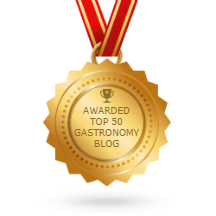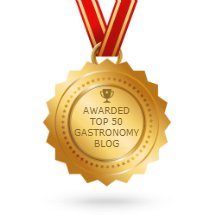* * * * *
Gildas (pronounced 'Hildas' in Spanish), the tapas whose curving anchovy bodies (salada, salty) alternating with olives (salada, salty) and picante guindilla peppers (verde & picante, green & spicy) on a skewer were inspired by Rita Hayworth's curves in the 1946 American movie 'Gilda,' which starred Hayworth and somehow made it past Generalisimo Franco's film censors since it was a pretty provocative "salada, verde and picante" (all of which have sexual connotations in Spanish) movie. Mercado de San Miguel, Madrid. (Note that these Gildas are made with boquerones en vinagre, fresh anchovies marinated in vinegar, not the traditional cured, salted anchoa normally used in making this pintxo.)
Gilda with the traditional cured anchovy at Bar Gorriti in the Casco Viejo (Old Quarter) of San Sebastiá
Spaniards went wild over the 1946 Rita Hayworth film "Gilda," which
first appeared in Spain at the end of 1947. In the grips of the Franco dictatorship, still
not ten years since the end of the Spanish Civil War, Spanish moviegoers were
so gobsmacked by Rita's sexiness and curvaceousness in Gilda, a movie which
somehow got by the very Catholic Franco regimes censors. At newly opened Casa Vallés in San Sebastián,
one of the bodega wine shop/food purveyor/bar’s habitues, a man named Joaquín
Aramburu, nicknamed “Txepetxa” (pronounced Chepecha), invented perhaps the first pintxo
(Basque for tapa).
Supposedly imitating Rita Hayworth’s voluptuousness, la Gilda was a cured
anchovy in olive oil curving on a toothpick around slightly picante
(Rita was certainly picante, or spicy, in Franco era Spain) green
peppers--verde, the Spanish euphemism for “green,’ or sexually naughty behavior;
a viejo verde is a dirty old man.
These green peppers, similar in taste and color to Greek pepperoncini peppers,
are called guindillas (or piparras in Basque), the most famous of
which came from the Guipuzcoan town (San Sebastián is in Guipuzcoa province) of
Ybarra, whose piparras/guindillas were locally referred as “langostinos de
Ybarra” (Ybarran prawns).
From ingredients—anchoas, guindillas and aceitunas
(olives)--available to customers at Casa Vallés,
Txeptxa used a toothpick to pinchar, poke a hole in or “pinch” the guindillas
doubled up and pierced through on four sides around which he curved an anchovy,
then skewered a round curvy olive (the breasts?) on to each end and the
curvaceous Gilda tapa, perhaps the very first pintxo, was born. The bar owners,
brothers Blas and Antxon Vallés, began putting the combination together,
and dubbed it la Gilda and offered it as a finished pintxo to its customers. Thus, Rita Hayworth's performance in Gilda
was immortalized in a tapa that can be found almost anywhere in Spain these
days.
Ironically,
Rita Hayworth (born Margarita Carmen Cansino) was of Spanish descent, Her father, a dancer, was from a town near
Sevilla, just as ironically, renowned as the capital and possibly, the origin,
of tapas in Spain. Her paternal grandfather,
Antono Cansino was also a famous dancer, who ran the top dance school in Madrid
and is credited with popularizing the bolero. The grandfather made the bolero famous;
his granddaughter gave the name to one of the most famous tapas in Spain.
Gilda, Bar Gandarias, (San Sebastián).
"The Gilda is considered to be the first ever Basque pintxo. It was created around 1947 at the Casa Vallés bar in San Sebastian, Spain. Putting out plates with olives, guindilla peppers and anchovies was the norm, but it was one of the bar’s regular patrons that created the pintxo by skewering the three ingredients together for the first time! The name was inspired by the film ‘Gilda’ that debuted at that time. The main character was a woman who was somewhat spicy and salty (not to mention curvy)– just like the taste (and curves) of the pintxo. Gilda Day was created in 2015 to celebrate this unique tapa!"--LaTienda.com
Comments are welcome and encouraged.
Text and photographs
copyright by Gerry Dawes©2021. Using photographs without crediting Gerry Dawes©2021 on
Facebook. Publication without my written permission is not authorized.
* * * * *
Shall deeds of Caesar or Napoleon ring
More true than Don Quixote's vapouring?
Hath winged Pegasus more nobly trod
Than Rocinante stumbling up to God?
Poem
by Archer M. Huntington inscribed under the Don Quixote on his horse
Rocinante bas-relief sculpture by his wife, Anna Vaughn Hyatt
Huntington,
in the courtyard of the Hispanic
Society of America’s incredible museum at 613 W. 155th Street, New York
City.
_______________________________________________________________________________________________
In 2019, again ranked in the Top 50
Gastronomy Blogs and Websites for Gastronomists & Gastronomes in
2019 by Feedspot. (Last Updated Oct 23, 2019)
"The Best Gastronomy blogs selected from
thousands of Food blogs, Culture blogs and Food Science blogs in our
index using search and social metrics. We’ve carefully selected these
websites because they are actively working to educate, inspire, and
empower their readers with frequent updates and high-quality
information."
36. Gerry Dawes's Spain: An Insider's Guide to Spanish Food, Wine, Culture and Travel
About Gerry Dawes
My good friend Gerry Dawes, the unbridled Spanish food and wine
enthusiast cum expert whose writing, photography, and countless
crisscrossings of the peninsula have done the most to introduce
Americans—and especially American food professionals—to my country's
culinary life." -- Chef-restaurateur-humanitarian José Andrés, Nobel
Peace Prize Nominee and Oscar Presenter 2019
Gerry Dawes is the Producer and Program Host of Gerry Dawes & Friends, a weekly radio progam on Pawling Public Radio in Pawling, New York (streaming live and archived at www.pawlingpublicradio.org and at www.beatofthevalley.com.)
Dawes
was awarded Spain's prestigious Premio Nacional de Gastronomía
(National Gastronomy Award) in 2003. He writes and speaks frequently on
Spanish wine and gastronomy and leads gastronomy, wine and cultural
tours to Spain. He was a finalist for the 2001 James Beard Foundation's
Journalism Award for Best Magazine Writing on Wine, won The Cava
Institute's First Prize for Journalism for his article on cava in 2004,
was awarded the CineGourLand “Cinéfilos y Gourmets” (Cinephiles
& Gourmets) prize in 2009 in Getxo (Vizcaya) and received the
2009 Association of Food Journalists Second Prize for Best Food Feature
in a Magazine for his Food Arts article, a retrospective piece about
Catalan star chef, Ferran Adrià.
".
. .That we were the first to introduce American readers to Ferran Adrià
in 1997 and have ever since continued to bring you a blow-by-blow
narrative of Spain's riveting ferment is chiefly due to our Spanish
correspondent, Gerry "Mr. Spain" Dawes, the messianic wine and food
journalist raised in Southern Illinois and possessor of a
self-accumulated doctorate in the Spanish table. Gerry once again
brings us up to the very minute. . ." - - Michael & Ariane
Batterberry, Editor-in-Chief/Publisher and Founding Editor/Publisher,
Food Arts, October 2009.
Pilot for a reality television series
on wine, gastronomy, culture and travel in Spain.



















No comments:
Post a Comment